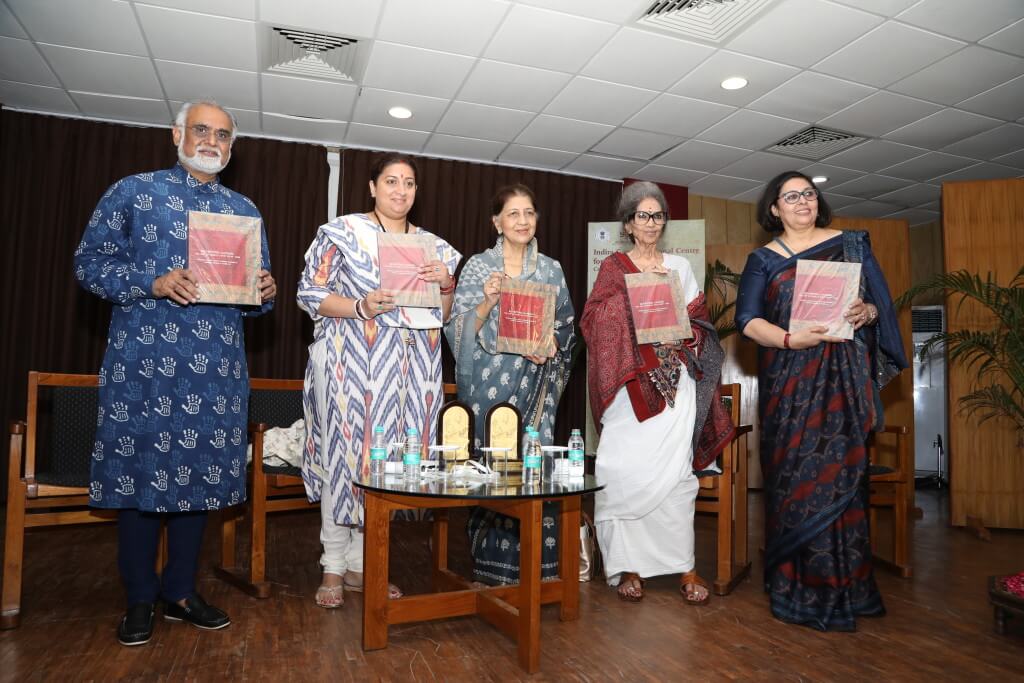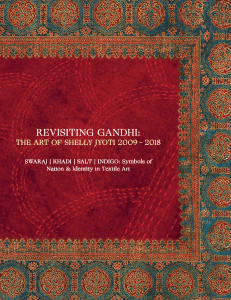Click to read the E-Catalog:
Revisiting Gandhi_E-Catalogue
Publication: Indira Gandhi National Centre for Arts, IGNCA
New Delhi
Pages :136 pages
Size: 9×11.5 inches
Catalogue Release:By
Hon Minister of Textiles, Smriti Irani jee
Tara Gandhi Bhattacharjee
Rajmata Shubhangini Raje Gaekwad of Baroda
Member secretary IGNCA, New Delhi

Keeping it for a Day for the Nation
Shelly Jyoti is driven by a mission; a mission to take the Gandhian ideals of Swaraj and Swadharma, which could be translated as ‘One’s Own Country’ and ‘One’s Own (moral) Duty’ respectively, from the annals of India’s national history to the living realities of the contemporary citizens of the country. It may seem a bit ambitious on the part of a visual artist who pursues an ideal that has got etched in her mind, strongly believing that the establishment of such a citizenry is possible provided each one harks keenly what Gandhi had said on his pet concepts of Swaraj and Swadharma and also sees what Shelly Jyoti has to say or rather show about these ideals/ideas via her favourite medium, textiles. As a textile designer-visual artist, Shelly swims in the ocean of India’s textile history like a fish with great ease and grace and by now has settled comfortably among the luminous corals of Indian Block Printing on fabric, which is otherwise known as Ajrakh. She flags out this area of fabric making and designing and considers it as a reliable realm replicable to create rural autonomy and sustainability as envisioned by Gandhi, and through her projects she has already emphasised this idea by exhorting the middle-class and rich urban populations to become annual patrons of this realm so that not only a few meters of the homespun or handspun fabric which is popularly known as Khadi could become a part of their daily lives but also could become a philosophy of organic life, simplicity, wholeness and the holistic well being of the human beings from both the urban and the rural sectors.
There is a tremendous optimistic reliance on the patronage as well as the traditional techniques of making Ajrakh visual design on the Khadi fabric created by Shelly Jyoti not just because she feels like working with textile as a medium for creating two or three dimensional works of art but because she has developed full faith in a sort of falling back on to an earthy, organic, traditional, rural and aesthetical method of production (of textile) which even though would not decelerate the pace of post-industrial and Information Technology based production, but perhaps would become handy in inculcating an alternative life style and world view. In the Post-Truth days of today palpable alternatives are sought after less and the pursuits of people are often guided by the socio-political and cultural meanings of what they consume rather than what they understand.
Here in this ‘Introspective’ exhibition what Shelly tries to showcase is not the essence of the relational values that come masqueraded as Truth values but to showcase an ensemble of possibilities where philosophical subtlety guides economic correction and creates cultural locations. In this Shelly imagines the possibility of bridging the gap between the ‘sanskar’ (organic, innate and traditionally chosen practices) and the culture (artificial, extraneous to basic living conditions and chosen by market decisions). This binary however needs further elucidation.
The modernist binary of nature/culture or here Sanskar for nature and Culture for culture is not self-exclusionary anymore. Nature no longer remains as a ‘pristine’ entity unvisited by culture at all. Similarly, culture is not a location or practice which is far away from nature. Interestingly, we constantly see one reproducing the other; information technology penetrating even into the remote parts of any country and concrete housing complexes developing ponds, forests, meadows and wildlife within their premises are examples to see how nature imitates culture and vice versa. In Shelly’s projects during the last one decade, one could witness this mutual reproduction of binaries. Shelly, as an urban artist imbibes the spirit and methodology of a rural fabric-making and designing practice with the help of the traditional practitioners of the art and craft form (here Ajrakh) and in turn they receive a culturally created idea of Swaraj and Swadharma from Gandhi via Shelly. Historical experiences have taught us how Gandhi had imagined and tried to put into practice a rural sustainable economy sitting in a liminal space (an interim space or a passage therefore not really a space at all!) while articulating his ideas on sustainable economy in 1909 while he was travelling by a ship.
A liminal space is a ‘no space’ also; it is a space/place in transition; that means the Gandhi who had started penning down the ideas of Swaraj the ship in his mother tongue Gujarati was not the Gandhi who had emerged from the voyage. The space in transition had made all the difference. Similarly when Shelly started working on the Ajrakh traditions a decade back, after creating series in making ‘lyrical abstractions’ on canvases, little did she know that she was entering in a space in transition. It was then she started reading Gandhi’s works to understand his involvement in the Champaran Movement in 1917. This movement had shaped the Gandhian struggle in India, which had a thorough base in his experiences in South Africa. Shelly soon found out how Champaran became a point of departure for Gandhi when he identified with the causes of the Indian farmers and Khadi became a practice and a metaphor in his political life. Shelly’s interest in Ajrakh and Indigo (which was the central point of the Champaran Movement) grew hand in hand and culminated in her exhibition ‘Indigo Narratives’ (2009). Shelly took it further as her interest in Indigo and Ajrakh became immense and the project took different shapes during the next eight years as she kept embellishing the project with her involved engagements.
Whether it was her interest in the textile or it was her fascination for Gandhian philosophy that took the upper hand by 2012, Shelly for sure found herself walking the same road that Gandhi had taken in 1930 when he marched with his disciples from Sabarmati Ashram in Ahmedabad to Dandi seashore to break the salt law imposed by the British. Shelly’s interest in Khadi and Ajrakh does not waver even if the metaphor has now shifted from Indigo to Salt. She presented ‘Salt, the Great March’ in 2013 and it travelled to many cities during the next two years. We see an interesting transferring of the political philosophy of Gandhi and its pivotal metaphors into the visual art practice by Shelly in this project. As Gandhi believed that there was a little bit of salt in everyone’s life, Shelly rightly believed that there was a little bit of Khadi in everyone’s life, and the belief still lingers on in her. In this project Shelly dealt with two metaphors in one go; one Khadi as a metaphor and two, salt as a metaphor. Looming large over these two metaphors was the metaphor of Gandhi himself and Shelly, perhaps for the first time yielded to the temptation of depicting Gandhi in his popular silhouette with a walking stick and in one of the works, as a pair of lean legs in brisk stride. This breakage from the pattern oriented depictions had underlined the urgency of a powerful and moving metaphor and had considerably contextualized the works of Shelly, who otherwise had been still fighting with the popular notions of being a textile artist and a textile designer and visual artist. ‘Salt the Great March’ that had consolidated Gandhi’s position in Indian politics at a crucial moment, the visual art project of the same name established Shelly’s position in Indian art too.
As mentioned at the outset, Shelly becomes a contemporary artist with a clear mission when she crosses over from ‘Salt the Great March’ to ‘The Khadi March: Just Five Meters’ (2016-17). By this time, Shelly has become a staunch follower of Gandhi’s Khadi Movement and has started believing in the possibility of changing the rural economy by making the urban patrons to buy ‘just five meters of Khadi’ so that the ‘sixty per cent of the illiterate rural population of India’ could develop a sustainable economy. At the outset, one may find it a bit Utopian an idea but as one goes into the nuances of it one would come to know that in the days of crowdfunding and online selling, chances are abundant for pooling in tremendous amounts of money through converting the rich urban population into sworn consumers Khadi. However, the irony is that even if the rich middle-class urban people talk a lot about their loyalty towards their country and try to wear their nationalism and patriotism on their sleeves when it comes to the core ideas of generating money for the stability of rural economy many take a few steps back. But Shelly’s optimism is infectious and she believes that as an artist she could instil this idea into the minds of the young and rich urban audience who eventually would understand the essence of Khadi as a ‘vichar’, a philosophy. What makes Shelly’s visual art ensemble appealing is her ability to shun sloganeering and package her ideas in attractive patterns, designs and forms using traditional Ajrakh technique on Khadi fabric. She beautifully blends two ways of production; the rural and urban thereby brings two worlds that are apparently set apart by socio-political and economic forces.
While creating works of art out of the Khadi fabric and employing Ajrakh printing methods, Shelly considers that she is in a process that needs meticulous design and technical support. The technical support comes from the traditional Ajrakh printers in the Kutch region in Gujarat, where Shelly had been a regular visitor during the last one decade. True to her guiding philosophy, Shelly brings the rural expertise to the urban galleries and prefers to call the technicians as her technical collaborators. A video that accompanies her visual art projects shows how she and her team of traditional technicians go through the fourteen stages of Ajrakh printmaking diligently before getting the final desired results. Shelly is an artist who explores the nuances of the binding theme and expands its scope to the complementary visuals as one sees in the works where the female garments become a central iconic presence. Here she speaks of the absence and presence of women in the social life of India and also she underlines the dignity that women prefer to carry in their personal life through self-reliance. The idea of Swarajya/Swaraj always comes to Shelly with the notion of collectiveness. She sees society as a collective body whose members ideally agree with each other. In reality that may not be the case, however, Shelly, as she underlines in her ‘Just Five Meters (of Khadi)’ a society, could progress if the members could stand together. She brings in the image of an emblematic pack of fishes to show this collectiveness. Also, Shelly brings forth the traditional images such as ‘wheels’ (suggesting progress and Time), ‘flags’ (pathfinding and triumph) and ‘flowers’ (purity and fecundity) along with embellishing bead works, embroidery and rarely hand painting. Shelly Jyoti’s creative world may look pattern-filled at the outset but as one goes deep into the nuances and intricacies, the underlying philosophy of autonomy, stability and social morality emerges from the fabric surfaces and with its persuasive force which leads the viewers to a special zone of aesthetical engagement.
by JohnyML, New Delhi based, art curator, writer

